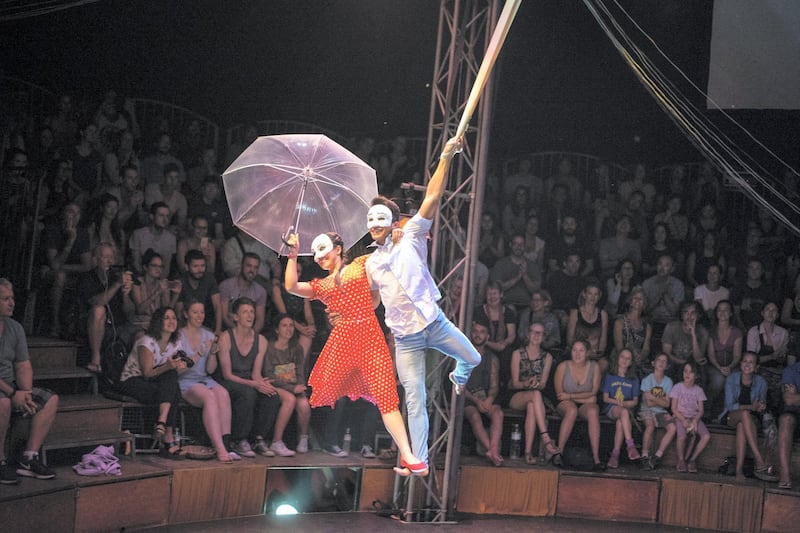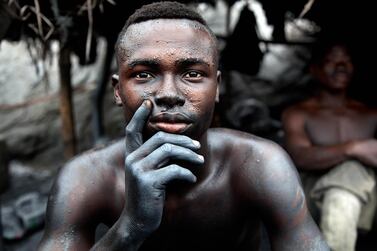When Choub Kanha was 6 years old, growing up in the remote Cambodian village of Battambang, her father bought her a hula-hoop. Her mother was worried, thinking the rigorous movement would prevent her being able to conceive children later in life, but Kanha was hooked. It awakened her passion for gymnastics and, over the next three years, she practised as many skills as she could at home, before she decided to join circus school.
Now, aged 24, as her peers primarily work in factories, on family farms or collecting recycling materials from rubbish tips, all while raising several children, Kanha works 18 to 20 days a month for Siem Reap's Phare circus, earning about four times the amount she would have had she chosen a more traditional role.
She and her only other female co-star, Nov Sreyleak, 29, say being such pioneers in their communities has not been easy. Their families have not always understood or approved of the artistic path they chose. Kanha’s father still does not, and even though she’s been in the show for six years, he has never made the journey from their village, a three-hour drive from Siem Reap, to see his daughter on stage, as she gracefully performs everything from backward walkovers to contortion stunts. Asked if this upsets her, however, she respectfully excuses him. “He’s busy,” she says.
Kanha is the youngest of seven children, two of whom died of childhood illnesses, which is still a common occurrence in the poverty-stricken villages of Cambodia. For her, joining circus school offered an escape. Now, her life is a long way from what it could have been. Her day-to-day schedule includes skilfully pulling off daredevil stunts, such as popping a balloon with an arrow fired with her feet while standing on her head. Her daily routine involves at least two hours of training, which includes stretching, strength drills and acrobatics. During her spare time, she rests, taking the regime in her stride, knowing it was more painful to reach this point than it is to maintain it.
Performance of any kind was banned in Cambodia during the reign of the brutal Khmer Rouge from 1975 to 1979. However, after the regime was overthrown, the Phare circus was founded as a school of art therapy for impoverished children. It is part of a larger non-profit school of the arts, Phare Ponleu Selpak, where 34 students are trained in circus skills. Shows are held three times a day in the 450-seat big top, and are often sold out. Until the younger performers move up the ranks, Kanha and Sreyleak will be needed to perform in all of them, as the routines rotate every eight to 10 days. This doesn't faze either of them, though, as they also work hard to actively encourage younger students to follow in their footsteps through workshops and regular school visits.
Cambodia has a long-standing tradition of acrobatic performances. References to the art form can even be seen on the carvings of the 800-year-old Angkor Thom temple. At Phare circus, the shows take inspiration from the country's rich culture. Eclipse, for example, draws on the elements of mysticism found in Cambodian mythology. It tells the story of a disfigured villager, believed to have been cursed by the gods, who was made an outcast. The rejected young man asks the gods for help, and they teach the rural villagers that it is not the man's fault he is disfigured and eventually he is welcomed back into the community.
Meanwhile, in the emotional drama Sokha, a child is haunted by the horrors and realities of life under the Khmer Rouge regime. Based on the experiences of the school's founders, the performance is a celebration of the revival and rebirth of the arts after that horrific period.
Despite the elaborate storytelling, the circus school's surroundings may seem basic, but this in no way reflects the level of talent on display in its shows. Artists defy death every day as they juggle fire, unicycle across tightropes and fly through the air on trapezes. These performers also go on to achieve great things outside their home country. Dina Sok, for one, began at Phare and can now be seen performing as a resident cast member of Cirque du Soleil in the US.
What started out with only a few plastic seats in a small corner of Siem Reap is now also one of the most popular tourist attractions in town – and offers an undeniably lucrative career for the talented few. Performers earn $43 (Dh157) per Phare show, plus extra working on other performances, which can offer up to $100 per show. It is a career that can fetch them a minimum of $500 per month. By comparison, factory workers in Cambodia earn roughly $120 a month and widespread poverty in the country means human trafficking and poor working conditions are rife. Phare offers its students a way out of this vicious cycle and has even attracted a few famous names in its audiences, such as actors Leonardo DiCaprio, Ted Danson, Harrison Ford, Mary Steenburgen and Calista Flockhart.
Growing up, Sreyleak, who joined the school aged 13, could not have imagined her life would turn out this way. She would spend half the day there, and the remainder selling cakes with her mother and sister. One of 11 siblings, she lost her father when she was 17 years old, after which the whole family became homeless. "I went to Phare to relieve the burden," she explains. Her mother was also taken on by the school as a cook. "I slept, studied and ate at school, which made it easier for my mother."
Sreyleak is an incredible talent today, but says performing was not something that came naturally. "I trained long and hard," she admits. "I cried when I was bent by my teacher … but I pushed through because I loved it." This is why she is so committed to recruiting the next generation. "I always explain to the young people I teach and meet that this has a good salary and an opportunity to travel, which Cambodians don't have. I explain the feeling you get when you see people clapping and cheering for you; they admire and respect us here."
It's great for women, too, she says. "People see that Cambodian women can be more than just people staying at home; they see us as someone to admire, with opportunities that others don't have. This is something to inspire all Cambodian women, and to show the world that we are different."
Kanha agrees, saying that, above all, the circus offers hope. “This is the time for us to be changing the role of women,” she says. “I hope we are empowering other women to see that their job is not just to be working in the home. They, too, can get an education – and have a different future.”






